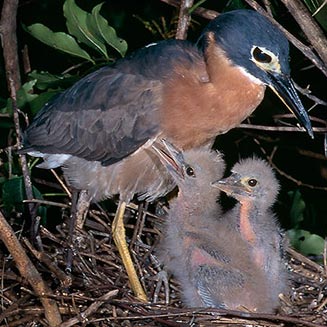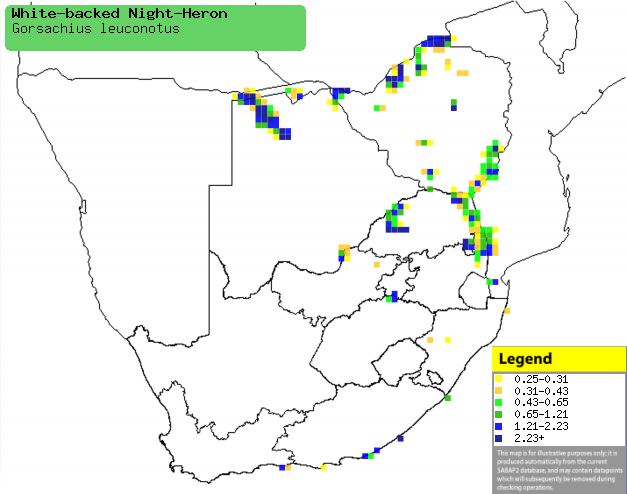|
Gorsachius leuconotus
(White-backed night-heron)
Witrugnagreier [Afrikaans]; Hakaruu (generic term for
short-necked herons and bitterns) [Kwangali]; Witrugkwak [Dutch]; Bihoreau
à dos blanc [French]; Weißrücken-nachtreiher [German];
Garça-nocturna-de-dorso-branco [Portuguese]
Life
> Eukaryotes >
Opisthokonta
> Metazoa (animals) >
Bilateria >
Deuterostomia > Chordata >
Craniata > Vertebrata (vertebrates) > Gnathostomata (jawed
vertebrates) > Teleostomi (teleost fish) > Osteichthyes (bony fish) > Class:
Sarcopterygii (lobe-finned
fish) > Stegocephalia (terrestrial
vertebrates) > Tetrapoda
(four-legged vertebrates) > Reptiliomorpha > Amniota >
Reptilia (reptiles) >
Romeriida > Diapsida > Archosauromorpha > Archosauria >
Dinosauria
(dinosaurs) > Saurischia > Theropoda (bipedal predatory dinosaurs) >
Coelurosauria > Maniraptora > Aves
(birds) > Order: Ciconiiformes
> Family: Ardeidae
 |
|
|
White-backed night-heron with chicks at nest,
Umhlanga Rocks Lagoon, South Africa. [photo
Hugh Chittenden ©] |
|
For information about this species, see
birdinfo.co.za.
Distribution and habitat
Occurs across sub-Saharan Africa; in southern Africa it is generally rare in northern Botswana, the Caprivi Strip (Namibia), Zimbabwe,
western Mozambique and north-eastern and
southern South Africa. It generally prefers clear and slow-moving watercourses
with overhanging vegetation, especially in woodland and forest but also in more
open country. It occasionally moves to lakes, dams, marshes, mangrove swamps and
occasionally reedbeds.
|
 |
|
Distribution of White-backed night-heron in southern Africa,
based on statistical smoothing of the records from first SA Bird Atlas
Project (©
Animal Demography unit, University of
Cape Town; smoothing by Birgit Erni and Francesca Little). Colours range
from dark blue (most common) through to yellow (least common).
See here for the latest distribution
from the SABAP2. |
Movements and migrations
Little known, but it is thought to be largely
resident, perhaps making occasional movements in response to
rainfall.
Food
Its diet is thought to mainly consist of fish, amphibians,
molluscs, crustaceans and insects, doing most of its foraging along the shallow
margins of water bodies. It hunts by either standing still and catching anything
that comes close, or by wading through the water and pursuing prey.
Breeding
- Monogamous solitary nester, building a stick platform lined with grass,
reed stems and leaves (see image at the top of the page). It is typically
concealed in a shrub or tree over or near water, such as Sycomore fig (Ficus
sycomorus), Powder-puff tree (Barringtonia racemosa), river-bean
(Sesbania), willows (Salix) or Cherry-pie (Lantana camara).
It may be placed in reeds or rock piles far from water, especially on
islands.
- Egg-laying season is year-round, peaking from March-May in northern
Botswana and from August-November elsewhere.
- It lays 2-4 eggs, which are incubated by both sexes for about 23-26
days.
- The chicks are brooded and fed by both parents, leaving the nest for
surrounding branches at about 20-21 days old. They leave completely at about
42-56 days old, although they remain dependent on their parents for a long time after
fledging.
Threats
Not threatened globally, but Vulnerable in South
Africa, largely due to habitat destruction and disturbance.
References
-
Hockey PAR, Dean WRJ and Ryan PG 2005. Roberts
- Birds of southern Africa, VIIth ed. The Trustees of the John Voelcker
Bird Book Fund, Cape Town.
|
